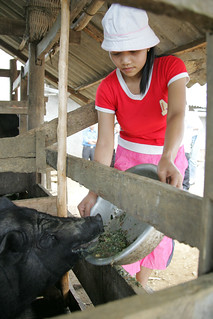 Jo Cadilhon (left) recently joined the International Livestock Research Institute as an agricultural economist with the Changing Demand and Market Institutions team. From 6-9 November 2012, he was among several scientists and other agricultural stakeholders who took part in an international conference organized by CTA in Addis Ababa, Ethiopia under the theme “Making the connection: Value chains for transforming smallholder agriculture”. He facilitated a session on capacity building in value chains and later during one of the conference field trips learned about an important value chain for livestock by-products: the Ethiopian leather industry. Below is his report.
Jo Cadilhon (left) recently joined the International Livestock Research Institute as an agricultural economist with the Changing Demand and Market Institutions team. From 6-9 November 2012, he was among several scientists and other agricultural stakeholders who took part in an international conference organized by CTA in Addis Ababa, Ethiopia under the theme “Making the connection: Value chains for transforming smallholder agriculture”. He facilitated a session on capacity building in value chains and later during one of the conference field trips learned about an important value chain for livestock by-products: the Ethiopian leather industry. Below is his report.
The International Livestock Research Institute (
ILRI) was a partner organizer of the
CTA conference on
Making the connection: value chains for transforming smallholder agriculture held from 6 to 9 November 2012 in Addis Ababa, Ethiopia.
One of the conference field trips organized by the United Nations Industrial Development Organization (
UNIDO) focused on leather products so I joined it to discover this value chain for livestock by-products.
I learned that good management practices by all stakeholders in the chain are just as critical for the quality improvement of livestock by-products as it is for the
quality and safety of food products derived from livestock.
Take the example of the leather industry in Ethiopia. Although selling animal hides for leather production is only a by-product for livestock producers, the local tanning industry can process up to 30,000 skins per day, producing leather for shoes and garments and creating significant employment, according to the
Leather Industry Development Institute.
 |
| Cattle being watered at the Ghibe River in southwestern Ethiopia. Simple improvements in the practices of livestock value chain stakeholders, such as avoiding inflicting wounds on the skin of cattle during herding, could help improve the quality of Ethiopian leather goods. (photo credit: ILRI/Stevie Mann). |
Crucially, simple improvements in herding, slaughtering, skinning and marketing practices in livestock value chains could help improve the quality of finished leather goods and thus increase the incomes for all value chain stakeholders.
For example, men’s shoes are cut out of cow skins. The various components of the shoes are cut from different areas of the skin: the shoulder and butt being stronger and of better quality than the skin from the belly and legs.
The job of the leather cutter is to optimize the number of shoe parts that can be cut out of one hide. If there are holes in the hide due to putrefaction of the skin before tanning, this decreases the number of shoe parts that can be cut out of one hide.
These holes are due to infected wounds in the skin. These wounds are usually inflicted on the animal during herding, slaughtering and skinning of the slaughtered animal.
Furthermore, there are usually several days before a hide reaches the tannery from the slaughterhouse through a very long chain of intermediary traders whereas the optimal time to preserve the quality of animal hides before tanning is just 24 hours.
This long time lag increases the likelihood of putrefaction of any wounds on the hides, thus decreasing the quality of the leather.
One indicator of leather quality is the homogeneity of the leather’s surface. When the live animal has been sick or infected by parasites scars and spots can appear on the skin, which then lead to stains and scars on the tanned leather.
The leather cutters and cobblers then have to work around these defects for fear of seeing the price of the final product depreciated.
Quality improvement in the Ethiopian livestock and leather industry is supported by
ILRI, the
Italian Development Cooperation, the United Nations Development Program (
UNDP),
UNIDO and the United States Agency for International Development (
USAID) through
linkages with the Leather Industry Development Institute.



